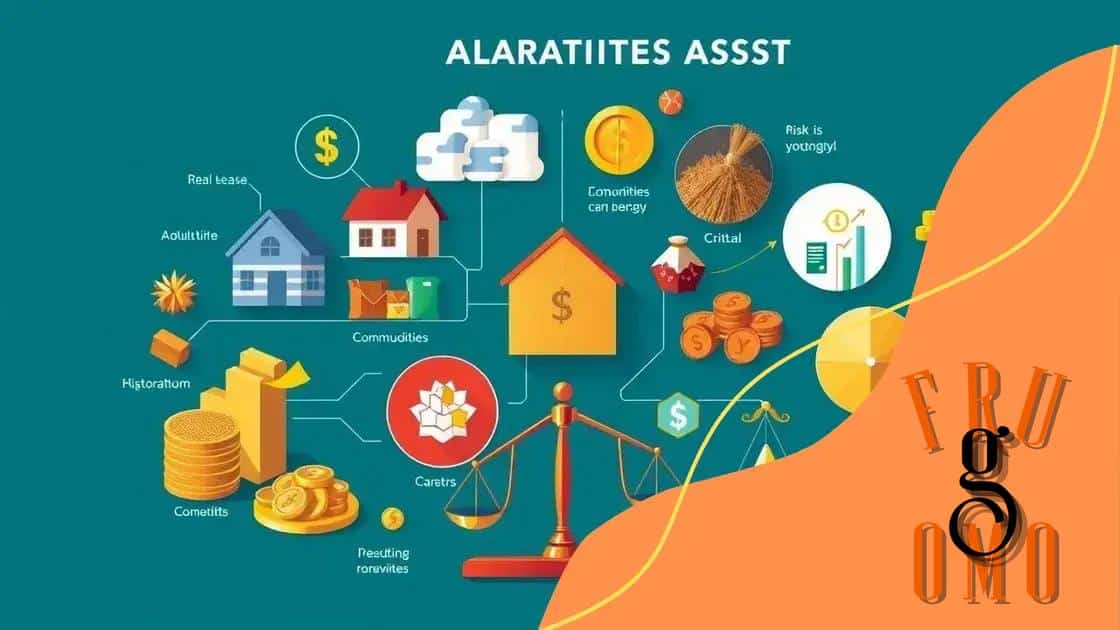Inflation hedging with alternative assets: strategies for success

Inflation hedging with alternative assets involves using investments like real estate, gold, and commodities to protect wealth against rising prices and economic fluctuations.
Inflation hedging with alternative assets is becoming increasingly important for investors looking to safeguard their wealth. Have you thought about how these strategies can enhance your portfolio? Let’s explore the options available and their potential impact.
Understanding inflation hedging
Understanding inflation hedging is crucial for investors seeking protection against rising prices. This strategy involves using various assets to maintain the value of investments when inflation erodes purchasing power. By employing effective hedging techniques, you can safeguard your wealth from unpredictable economic shifts.
When diving deeper into inflation hedging, it’s essential to know the types of assets you can utilize. These assets can act as shields against inflation’s negative impacts. Common options include real estate, commodities, and precious metals.
Types of assets for hedging
Investors often turn to several key areas when considering inflation hedging. Real estate is favored because it typically appreciates over time, often keeping pace with or exceeding inflation rates. Similarly, commodities such as oil, gold, and agricultural products tend to rise in value when inflation surges.
- Real Estate: Provides rental income and appreciates in value.
- Precious Metals: Gold and silver are traditional hedges.
- Commodities: Includes agricultural products and energy resources.
- Cryptocurrencies: Some believe they can serve as a hedge in digital format.
Another fascinating approach involves stocks in specific sectors. Utilities and consumer staples often maintain steady performance despite inflation. Investors should consider these sectors for a balanced portfolio that withstands economic fluctuations.
Additionally, incorporating TIPS (Treasury Inflation-Protected Securities) can be a wise tactic. These government bonds adjust with inflation, providing a safety net for your investments. Monitoring interest rates is also essential, as high rates can signal changes in inflation trends.
In summary, understanding inflation hedging helps you protect your finances effectively. Exploring various asset types, including real estate, commodities, and TIPS, ensures you remain prepared for economic challenges.
Types of alternative assets
When it comes to inflation hedging, understanding the types of alternative assets is essential for any investor. These assets can provide valuable protection against the erosion of purchasing power. They range from tangible items like real estate to commodities like gold.
One of the most popular categories is real estate. This can include residential properties, commercial buildings, and rental homes. Real estate often appreciates over time and can generate rental income, making it a strong hedge against inflation.
Common types of alternative assets
In addition to real estate, there are other effective options. Commodities such as gold, silver, and oil have historically performed well during inflationary periods. They tend to retain value when currency depreciates. Investors often buy these assets to preserve wealth and counteract inflation.
- Gold: A traditional safe haven, gold usually sees price increases during economic uncertainty.
- Silver: Like gold, silver can also act as an inflation hedge with industrial demand.
- Energy Resources: Oil and gas can rise in value along with inflation, making them solid investments.
- Collectibles: Items like art, antiques, and rare coins can appreciate significantly, especially during times of economic instability.
Another valuable category is alternative investments, which include private equity and hedge funds. These investments can provide diversification beyond traditional stocks and bonds. They often involve varying levels of risk and return, which can be attractive for investors looking to hedge against inflation.
It’s also worth noting cryptocurrencies, which have gained popularity as alternative assets. While they are still somewhat volatile, some investors believe cryptocurrencies can provide an effective hedge due to their decentralized nature.
Understanding the types of alternative assets available allows investors to build a resilient portfolio. By strategically incorporating them, you can better protect your finances from inflation’s impact.
Evaluating risks and benefits

When evaluating risks and benefits of alternative assets for inflation hedging, it’s essential to analyze both sides thoroughly. Each investment type carries unique risks that can impact overall financial security.
Understanding these risks starts with recognizing market volatility. Many alternative assets, like real estate and commodities, can fluctuate significantly. When choosing an asset, investors must consider how these fluctuations can affect their portfolio.
Key risks to consider
Beyond market volatility, there are other crucial factors to examine. Liquidity risk is important because some alternative assets, such as collectibles, can be hard to sell quickly. This can affect your ability to access cash during urgent situations.
- Market Volatility: Prices can change rapidly based on economic conditions.
- Liquidity Risk: Difficulty in selling assets can limit cash access.
- Management Costs: Maintenance and fees for properties can add costs.
- Regulatory Risks: Changes in laws can impact asset values or profitability.
However, there are many benefits to consider as well. Investing in alternative assets can provide diversification, which is crucial for managing risks. By spreading investments across different types, you can lower the overall risk in your portfolio. Furthermore, many alternative assets have shown a strong historical performance during inflationary periods.
For instance, real estate properties often appreciate over time, allowing landlords to increase rent prices in line with inflation. Similarly, precious metals like gold have consistently held their value, making them a safe haven during economic downturns.
Understanding both the risks and benefits helps investors develop a comprehensive strategy for their portfolios. By balancing these factors, you can effectively utilize alternative assets in your inflation hedging approach.
Practical strategies for investment
Implementing practical strategies for investment in alternative assets can greatly enhance your approach to inflation hedging. These strategies are designed to help you make informed decisions and optimize your portfolio for better protection against rising prices.
One of the most effective strategies is to diversify your asset base. By spreading your investments across real estate, commodities, and even cryptocurrencies, you can reduce risk. Diversification helps to ensure that if one asset class underperforms, others might compensate for it.
Key strategies to consider
Another important strategy involves regularly reviewing and adjusting your portfolio. The market is dynamic, and what’s profitable today may not be tomorrow. For instance, if you notice that inflation is increasing, you might want to increase your holdings in precious metals like gold or increase your stakes in real estate.
- Rebalancing Portfolio: Regular adjustments ensure that your investments align with your risk tolerance and market conditions.
- Research Trends: Stay informed about market trends and economic indicators that can impact your investments.
- Utilizing Technology: Use financial tools and platforms to track your investments and analyze performance.
- Building a Strong Network: Connect with other investors or financial advisors for insights and tips.
Another method is to consider leveraging investment vehicles like REITs (Real Estate Investment Trusts). These allow you to invest in real estate without the need to buy properties directly. REITs can provide both income and growth, making them suitable for inflation hedging.
Finally, don’t overlook alternative investments like artworks or collectibles. These types of assets can also appreciate significantly, especially during economic uncertainty. Investing in such tangible items can diversify your portfolio further while protecting against inflation.
By employing these practical strategies for investment, you can take proactive steps to shield your wealth and navigate the complexities of inflation. Building a resilient portfolio is key to securing your financial future.
Real-world examples of successful hedging
Examining real-world examples of successful hedging provides valuable insights for investors. These case studies can illustrate how various alternative assets have been effectively used to combat inflation.
One notable example is the use of real estate during periods of high inflation. For instance, in the late 1970s, U.S. housing prices rose significantly. Investors who purchased rental properties not only benefited from increased property values but also enjoyed rising rents, which kept pace with inflation.
Successful hedge with commodities
Another excellent example involves commodities like gold. During economic downturns, investors often flock to gold as a safe haven. For example, when the financial crisis struck in 2008, gold prices soared as people sought to protect their wealth. Those who invested in gold before the crisis saw substantial returns, showcasing gold’s effectiveness as an inflation hedge.
- 2008 Financial Crisis: Gold prices skyrocketed as investors sought safety.
- Real Estate in 1970s: Housing prices and rents spiked, benefiting property owners.
- Oil Prices: During recent inflation surges, investors in energy stocks saw significant gains.
- Collectibles: Artwork and rare coins have appreciated during inflationary periods.
Additionally, some investors have successfully hedged against inflation by diversifying into alternative investments like fine art or rare collectibles. For instance, a piece of art that was purchased for $10,000 in the early 2000s may now be worth several times that amount, especially during inflationary cycles when traditional investments falter.
Another compelling case is the performance of agricultural commodities during inflation. When food prices rise, investments in commodities like wheat or corn can yield excellent returns. Farmers and agricultural investors often hedge against inflation by locking in prices through futures contracts, ensuring profitability regardless of market fluctuations.
These examples highlight the importance of understanding how different assets respond to inflationary pressures. By analyzing successful strategies and case studies, investors can build robust strategies for their own financial futures.
FAQ – Frequently Asked Questions about Inflation Hedging with Alternative Assets
What are alternative assets?
Alternative assets are investments that fall outside traditional asset classes, such as stocks or bonds. They include real estate, commodities, and collectibles.
How does real estate act as an inflation hedge?
Real estate tends to appreciate in value over time and often generates rental income, which can increase with inflation, making it a good hedge against rising prices.
What role do commodities like gold play in inflation hedging?
Commodities like gold are considered safe havens during economic uncertainty. They typically retain value or appreciate when inflation rises.
How can I diversify my investments to hedge against inflation?
You can diversify by incorporating various assets like real estate, gold, and other commodities, as well as alternative investments, to reduce risk and enhance potential returns.





